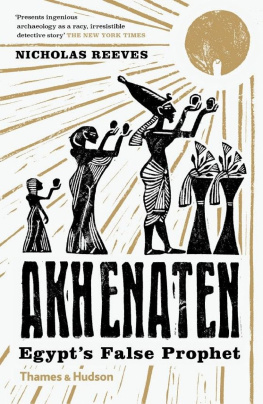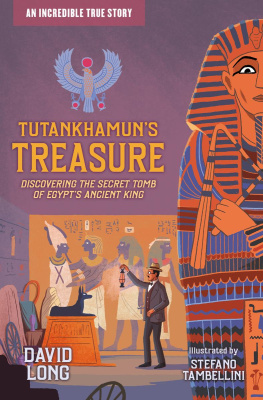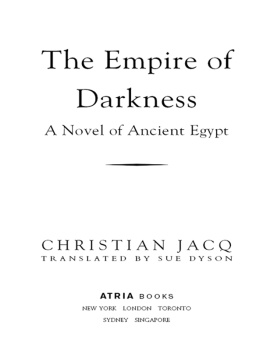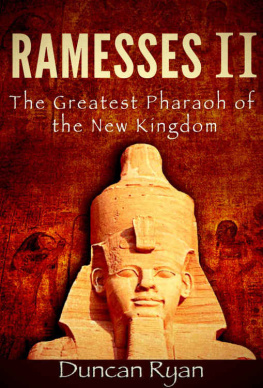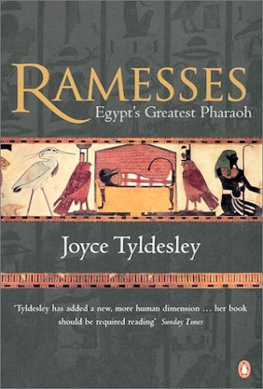PENGUIN BOOKS
RAMESSES
Joyce Tyldesley is Honorary Research Fellow at the School of Archaeology, Classics and Oriental Studies at Liverpool University, and a freelance writer and lecturer on Egyptian archaeology. Her previous books include Daughters of Isis: Women of Ancient Egypt, The Mummy: Unwrap the Ancient Secrets of the Mummies Tombs, Hatchepsut: The Female Pharaoh and Nefertiti: Egypts Sun Queen.
RAMESSES
EGYPTS GREATEST PHARAOH
JOYCE TYLDESLEY

PENGUIN BOOKS
PENGUIN BOOKS
Published by the Penguin Group
Penguin Books Ltd, 80 Strand, London WC2R 0RL, England
Penguin Putnam Inc., 375 Hudson Street, New York, New York 10014, USA
Penguin Books Australia Ltd, 250 Camberwell Road, Camberwell, Victoria 3124, Australia
Penguin Books Canada Ltd, 10 Alcorn Avenue, Toronto, Ontario, Canada M4V 3B2
Penguin Books India (P) Ltd, 11 Community Centre, Panchsheel Park, New Delhi 110 017, India
Penguin Books (NZ) Ltd, Cnr Rosedale and Airborne Roads, Albany, Auckland, New Zealand
Penguin Books (South Africa) (Pty) Ltd, 24 Sturdee Avenue, Rosebank 2196, South Africa
Penguin Books Ltd, Registered Offices: 80 Strand, London WC2R 0RL, England
www.penguin.com
First published by Viking 2000
Published in Penguin Books 2001
Copyright J. A. Tyldesley, 2000
All rights reserved
The moral right of the author has been asserted
Except in the United States of America, this book is sold subject to the condition that it shall not, by way of trade or otherwise, be lent, re-sold, hired out, or otherwise circulated without the publishers prior consent in any form of binding or cover other than that in which it is published and without a similar condition including this condition being imposed on the subsequent purchaser
ISBN: 978-0-14-194978-9
For my parents Anne McGregor and William Tyldesley
Contents
List of Plates
Photographic Acknowledgements
AKG London:
Henning Bock:
Erich Lessing:
Robert ODea:
Bildarchiv Preussischer Kulturbesitz, Berlin:
British Museum:
ET Archive:
Giraudon, Paris:
Michael Holford:
Scala, Florence:
Werner Forman Archive/E. Strouhal:
List of Figures
Preface
.
Chapter 1
Chapter 2
.
.
Chapter 3
.
.
Chapter 4
.
Chapter 5
Chapter 6
.
Chapter 7
.
.
Chapter 8
.
.
.
.
List of Maps
Acknowledgements
Professor Kenneth Kitchen has very generously devoted a great deal of his precious time to reading this text and answering my queries. I am very grateful to him. I would also like to thank Steven Snape for his tireless assistance with references and illustrations. Philippa and Jack tried, and sometimes managed, to be quiet while I worked: thank you.
Preface
New Readers Start Here
Egyptology the study of Egypts distant past via a combination of linked disciplines including archaeology, history and the sciences attracts a disparate band of devotees with varying degrees of knowledge. Many so-called amateur Egyptologists are as well informed as any professional and will already be familiar with the complexities and pitfalls of their chosen subject. Other readers, those new to the delights of ancient Egypt, may feel less confident in their understanding of the background to this book. Egyptology has over the years developed its own terms and conventions, which in extreme cases make more specialist publications inaccessible to the general public. The following notes are therefore offered as a brief introduction for all new readers, and as an aide-mmoire to the more experienced.
Egyptologists invariably use dynasties and individual regnal years rather than calendar years to date the events of the past. Under this system Ramesses II may be classified as the third king of the 19th Dynasty, a sub-division of Egypts New Kingdom. We know that Ramesses reigned for over six decades. His precise calendar dates are by no means certain but on current evidence 127913 BC (or less likely 129024 BC ) seem the most probable; 13041238 BC , which may be found in some older references, is now known to be incorrect.), allowing Ramesses to be set in his proper historical context.
During the New Kingdom every king of Egypt acquired, at his succession, a series of five names or titles which reflected aspects of his kingship. These names/titles took the form of little sentences and were effectively political statements or statements of allegiance to particular gods. Thus, as he assumed the throne, Ramesses became:
- The Horus King, Strong Bull, Beloved of Right, Truth.
- He of the Two Ladies, Protector of Egypt who curbs the foreign lands.
- The Golden Horus, Rich in Years, Great in Victories.
- King of Upper and Lower Egypt, Usermaatre [Setepenre was added from Year 2 of his solo reign]
- Son of Re, Ramesses II, Beloved of Amen.
The last of these names, known as the nomen, was the kings personal name, the name which had been given to him at birth and which his immediate family would have continued to use after his accession. The preceding name, the throne name or prenomen, was his more formal appellation, used in diplomatic correspondence; thus foreign rulers correctly addressed Ramesses as Usermaatre (User-Maat-Re, literally Strong in Truth in Re). Only the nomen and the prenomen were written within the cartouche, the oval loop which protected and distinguished the names of all Egyptian kings and some of their queens. Ramesses inscriptions generally bore his nomen and prenomen plus as many additional names/titles as space would permit. The full complement of names and titles would be reserved for the most important of his monuments.
It is difficult to know where to begin writing the history of any one pharaoh as no monarch can be isolated from his countrys immediate past. The Ramesside kings, arrivistes with a strong urge to justify their hold on the Egyptian throne, constantly looked to the precedents set

Fig P.1 The cartouches of Usermaatre Setepenre Ramessu Meriamen: Ramesses II, Beloved of Amen
by the successful pharaohs of the preceding dynasty, finding particular inspiration in the military exploits of Tuthmosis III and the internal policies of Amenhotep III. It is therefore necessary to understand something of 18th Dynasty history in order to appreciate the motivations of the 19th Dynasty kings. Many authors delve back to the dawn of the dynastic age in order to provide a full historical background to their study. I have chosen to start the story of Ramesses with the late 18th Dynasty rule of Horemheb, the pharaoh who did much to establish the stability of the 19th Dynasty after the upheavals and political uncertainties of the unconventional Amarna period. This book therefore forms the final volume in a loose trilogy encompassing the history of the New Kingdom, the earlier books being Hatchepsut: the female pharaoh, and Nefertiti: Egypts sun queen. Readers requiring more background information are referred to the suggested Further Reading given at the end of the book. The notes that accompany each chapter have been used to suggest more specialized references in English, French and German.
Egyptologists, like detectives, piece together evidence gleaned from a variety of sources in order to reconstruct the events of the past. Unfortunately the ancients were not in the habit of burying carefully constructed time-capsules and so the evidence which has survived the centuries invariably comes complete with its own particular flaws and biases. There is certainly no need to apologize for the quality or quantity of information recovered from Egypt we know far more about the life and thoughts of the ancient Egyptians than we do of, say, their contemporaries living in the British Isles but new readers should be aware of some of the challenges posed by the evidence.


